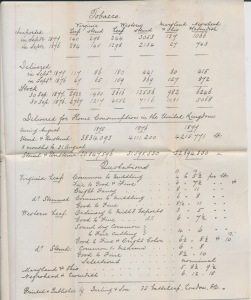Economic theory extols the virtue of trade and many anthropologists credit trade with being among the human inventions that most advanced civilization and material wealth. Stamps facilitated trade as their invention and use made communications easier, and ease of communications is one of the conditions that improves trade. Throughout the Nineteenth Century it was agricultural products that were the most traded and tobacco was one of the most widely traded and transported agricultural commodities. Tobacco was addictive so its market was ever expanding and unresponsive to changes in taste and fashion. Tobacco grew only in certain climates far removed from Europe where it was needed and tobacco required little care after harvesting making it an ideal crop for transport and trade. Rats didn't eat it and it could be stored for a long time. The letter illustrated above ( and we scanned the folded letter and then opened it out so you can read it) is an example of the kind of interrelatedness of stamps and trade that makes postal history so interesting. It is a printed tobacco circular from 1877 from a tobacco merchant and importer in London to a grower in Lynchburg Virginia. An interesting thing about this circular is the fact that is handwritten and then printed in a sort of mimeograph process. This was an attempt by the merchant to make the letter look like a personal one while at the same time preserving the advantages of the "circular" postage rate. At this time private letters from Great Britain to the US were a shilling a piece as opposed to 1p for a circular so the London tobacco merchant was maximizing his direct mail dollars by the way he sent this letter. This is yet another thing that stamp collecting shows us. Though products and technology change, marketing still has the same goals it always has had.
Tobacco
Archive



